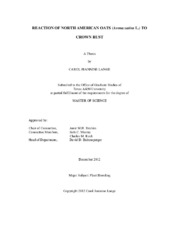| dc.description.abstract | Crown rust, caused by the fungus Puccinia coronata, is a severe disease negatively impacting seed quality and yield in oat (Avena sativa). Host genetic resistance is the primary means for controlling this disease. The most extensive oat map contains nearly 2,500 genetic markers, many of which are restriction and amplified fragment length polymorphic (RFLP or AFLP) markers. However, the use of more abundant single nucleotide polymorphic (SNP) markers combined with diversity arrays technology (DArT) would be more advantageous for marker assisted breeding (MAB) and genome wide selection (GWS) applications due to the availability of high density genotyping technologies. The purpose of using this technology is to improve the competitiveness of oat by producing varieties with durable resistance to crown rust and desirable traits that will benefit oat growers in the U.S. Panels of winter and spring oat were evaluated for resistance to crown rust in four field environments in Texas, Louisiana, Minnesota, and North Dakota during a two-year study in 2010 and 2011. Plants representing 702 elite lines of oat were phenotyped for crown rust resistance and found to have highly diverse responses. The winter oat lines demonstrated the best crown rust resistance and are expected to yield the most QTL to be used in developing durable crown rust resistance. Heritability of crown rust resistance in this study ranged from 0.88 to 0.90 in spring and winter oats, respectively. Crown rust measurements were also found to be repeatable. Repeatability ranged from 0.56 to 0.88 at Castroville, TX in 2011 and 2010, respectively in spring oats and from 0.79 at St. Paul, MN in 2011 to 0.96 at Castroville, TX in 2010 in winter oats. Oat lines contributed by states along the Puccinia pathway in Texas, Louisiana, Minnesota, North Dakota, and Wisconsin on average exhibited the best crown rust resistance as compared to other areas in the country where spring and winter oat are grown. GGE biplot analysis indicated that Castroville, TX was the most representative and most ideal testing location. The above results are expected to increase knowledge of the genetic diversity of the oat germplasm, yield comprehensive genotyping and phenotyping information for North American oat breeding programs, and to promote further use of GWS and MAB for key traits regarding disease resistance in oat. Future work is to conclude the association mapping process by completing genotypic analysis. | en |


